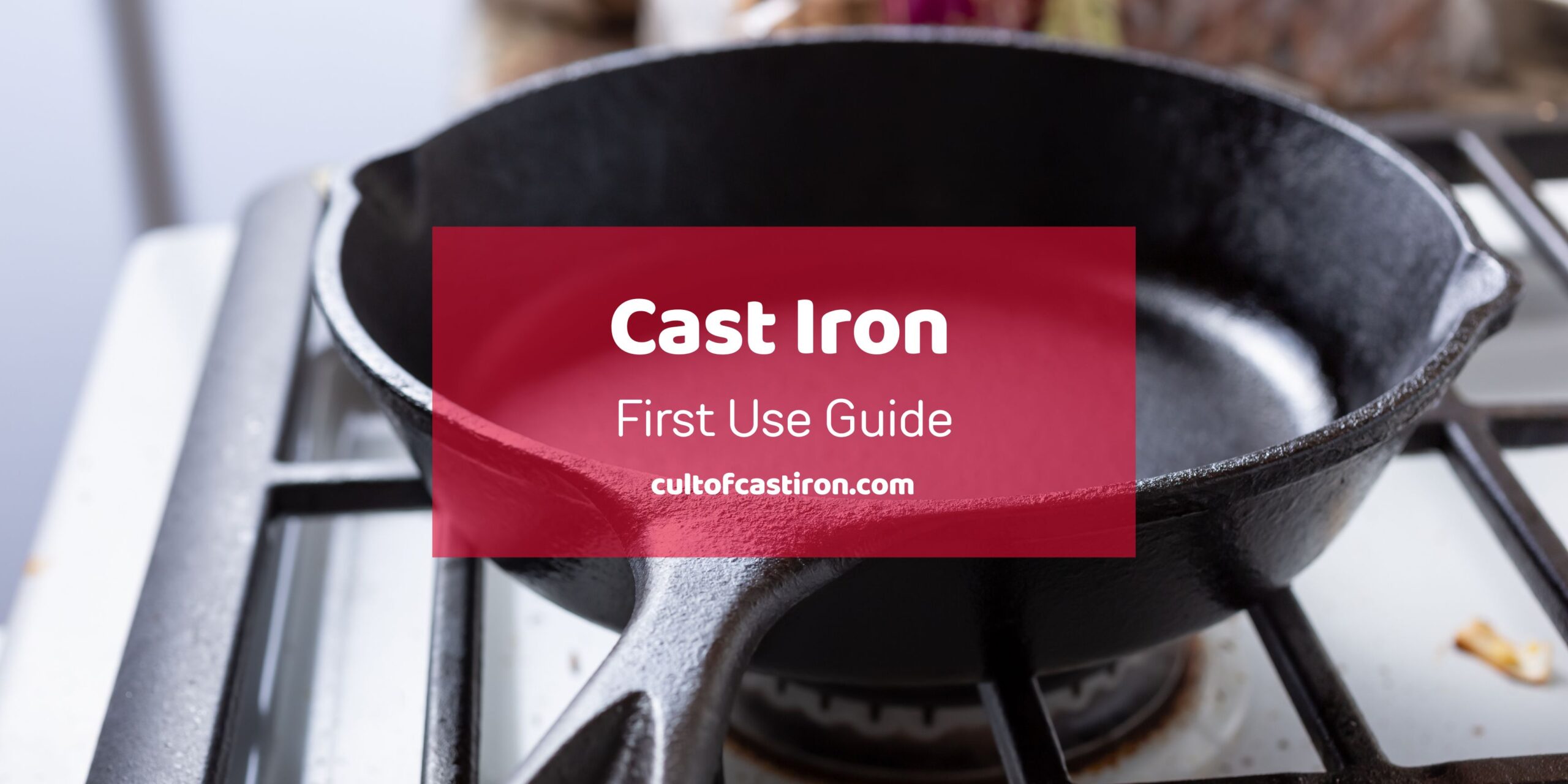Welcome to the world of cast iron cooking! You’ve made a wise investment in an incredibly durable and versatile cookware that will last you decades with proper care.
But before you start cooking up a storm, it’s important to know how that there is a learning curve when it comes to cooking with cast iron for the first time. To help you ease into things, I’ve created this cast iron first-use guide to walk you through the initial phases of ownership and answer the most common questions associated with cast iron cooking.
This guide will cover the steps to take before using your cast iron skillet for the first time, tips on how to cook using it, and other common questions regarding usage, cleaning, and maintenance. Let’s dive in, shall we?
What To Do Before Using A New Cast Iron Skillet For The First Time
Unlike in the early 1900s, most cast iron skillets now come pre-seasoned from the factory, which means that you do not have to season these pans on your own at home. However, it is recommended that you wash and oil your new skillet before using it for the first time to wash off the dirt that might have accumulated while it is in storage or transit.
Washing a cast iron pan takes a little bit more steps than washing any other type of cookware, but it is not necessarily harder to do. Here are the steps in detail.
Wash the skillet with soap and water
First, you should wash the skillet with light soap and warm water to sanitize its surface. Also, you need not worry about using soap on a cast iron skillet – as long as the soap is mild, it will not do harm to your pan.
Rinse and let dry the skillet with a towel
After washing the skillet, wash off every trace of soap on the pan, and dry it with a towel. Try to get as much moisture out of the pan at this point to shorten the next step below.
Heat the skillet until bone dry
To prevent the skillet from rusting during storage, you must make that it is bone dry first. To do this, you must heat the skillet on the stove until you cannot see any trace of moisture on the surface, or until it starts to smoke.
Apply oil all over the surface
Now that the skillet is dry, you must now put a generous glug of oil all over the pan. Not only does this protect the pan from rusting, but it will also develop into a nice layer of seasoning later on. Make sure to include the handles and the underside of the pan as well for total protection.
Wipe away excess oil
Next, you should wipe away any excess oil on the pan. Remember: only a thin film of oil is needed to develop a strong layer of seasoning, and all of the oil you’re going to need is likely already stuck on the surface, so don’t hesitate to wipe off excess oil with a towel. This actually prevents you from having to deal with a sticky cast iron seasoning later on.
Use the skillet (or store it away)
Now that the skillet is sufficiently oiled, it can already be used for cooking! Alternatively, you can now put it away without fear of it developing rust while in storage. However, if you are really excited about using your new kitchen toy, we’ve laid out a few tips and tricks when it comes to cooking with a cast iron pan.
How to Cook with a Cast Iron Skillet: 7 Tips for New Users
Proper seasoning and storage are a big part of the learning curve when it comes to using a cast iron skillet. However, the cooking performance and dynamics of cast iron cookware are a lot different compared to other materials like stainless steel, copper, or aluminum. Here are some general tips on how to get the hang of cooking with a cast iron skillet for new users.
1. Make sure to preheat your skillet
Cast iron can take far longer to heat up compared to other types of materials. Hence you must sufficiently preheat your skillet first before cooking food with it. Remember: placing food on top of a cold pan almost always results in it being stuck on the pan.
To preheat the pan, put it on low to medium heat for 5 minutes or so. You’ll know you’re good for cooking once it begins to emit smoke. For the impatient ones (like me), I put the pan on high heat, but I rotate the pan every 15 seconds or so for a minute (more on this later) to heat it quickly. Once the pan is smoking, I turn down the heat to my actual cooking temperature and let it rest for a minute until it comes down to the ideal temperature.
2. Add a generous amount of oil
Now that the pan is sufficiently hot, you must put a generous amount of oil on the skillet. You’ve got to remember that the pan does have a well-developed seasoning yet, so it needs a lot of lubrication to prevent food from sticking on the surface. Once the oil is brought to the optimal temperature, you can now put your food in it and start cooking.
3. Use a pot holder at all times
Here’s what I learned the hard way the first time I used my cast iron pans: their handles get hot. Way hot. I had a lot of burns on my hands the first few days of using the skillet as I was used to using the rubberized handles of my parent’s non-stick skillet at home. Since cast iron pans are just one slab of metal, the heat will conduct its way to the also-made-of-metal handle and give a nasty surprise to the absent-minded (like me!) who touches the handle.
Ever since then, I’ve been using a pot holder at all times when I’m cooking with a cast iron pan. You can also buy oven-safe silicone handles that will protect your hands from being burned. But in my experience, they still end up being too hot to handle, and you’ll still need a pot holder to touch the handle without it being uncomfortably hot on your hands.
4. Rotate the pan once in a while
Since cast iron is a poor conductor of heat, it will generally take longer to sufficiently heat the pan before cooking. Moreover, this may result in uneven temperatures across the pan. To get around this, I rotate my pan on the stove to help it achieve a consistent temperature along its surface. This is particularly needed for 10-inch pans and up.
For me, I imagine that the pan’s handle is the hand of a clock; I usually start at the 6 o’clock position and rotate clockwise to the 9, 12, and 3 o’clock positions. I change the position of the pan every minute for the first few minutes of cooking to make sure that it achieves an even temperature quickly. After around 10 minutes or so, the pan may have already accumulated enough thermal energy evenly across the pan, so rotating it is not as urgent now, but it is still a good practice though!
5. Let the Maillard Reaction do its thing before flipping food
For fidgety cooks (again, like me!) who like to frequently toss and turn their food to check whether the underside is properly cooked, the cast iron skillet may be quite unforgiving as food tends to stick to the pores of the pan, particularly for the first few weeks of use. This is because the pan’s seasoning is still developing, and hence its non-stick quality is still not up to snuff. To minimize this, you must let the Maillard Reaction take place and firm up its texture before flipping or moving them around.
The Maillard Reaction happens when the heat makes the natural sugars and proteins in the food react. This produces complex flavors and aromas in food and imparts brown coloration on food. More importantly for this point, it results in the formation of the seared crust that helps it easily lift off the pan when flipped.
If you flip the food too soon, you interrupt this reaction, and you’ll likely ruin the presentation of the food or cause it to stick to the pan. So, it’s best to let the food cook on one side for a bit before flipping it over to allow the Maillard reaction to complete.
6. Be mindful of cooking with acidic ingredients
Before tossing in your favorite acidic ingredients like fruits, tomatoes, vinegar, etc., you must understand that these acids may react with your skillet’s seasoning. First, you may see some black specks in your food – these are bits of the seasoning flaking off as their bond to the metal is weakened by the acids. Moreover, cooking acidic food in a cast iron skillet leeches iron molecules in your food, which may impart a metallic taste in your meals (it does increase your dietary iron intake though.)
Now, I’m not saying that you should not cook acidic foods in your cast iron skillet at all costs. I’m just saying that it may be better to develop a strong layer of seasoning first so that you won’t impart black specks and a metallic taste to your food.
7. Choose wooden or silicone utensils over metal ones
If you are a former non-stick pan user, you may already know that it is a big no-no to use metal utensils while cooking as this may scratch off the teflon coating of the pan. It is quite the same for cast iron skillets – well, at least for new ones.
Again, the pre-seasoning layer of the skillet tends to be weak, hence they can be easily scratched off by a metallic cooking utensil. While it is not a big deal as the seasoning can be repaired (quite unlike a non-stick pan), I’d say that prevention is better than cure.
Cooking with utensils made from wood or silicone is a great way to not damage your pan’s seasoning. And as the seasoning develops over time, it can now be more resilient to metal utensils, so you can switch later on if you’d like.
What Other Things Can You Do With a Cast Iron Skillet?
It is no secret that cast iron skillets are incredibly versatile in the kitchen. Here are some of the cooking techniques that you can do with it.
Most types of frying
You’ll probably use your cast iron skillet for frying stuff 90% of the time. You can pan-fry, sear, stir fry, and saute food with it. However, I wouldn’t recommend deep frying with it as it is too shallow for that – leave it to other types of cast iron cookware like its cousin the deep skillet, or even in a Dutch oven.
Baking, roasting, and broiling
Cast iron skillets are oven safe, which means that you can use them as a baking pan, or roast meats and vegetables with them in an oven. You can even do the reverse sear method, where you cook meat in the oven at low or medium heat for even cooking, then sear it on a stove at high temperature for a beautiful crust. Conversely, you can sear the crust first on the stove and finish cooking in the oven to prevent the crust from being burned.
Cooking over an open fire
Since cast iron skillets can withstand high temperatures, they can be used for open-fire settings like over the grill or over a campfire. This is why cast iron cookware is typically used by campers the world over.
Cast Iron Skillet First Use FAQs
Now that we’ve covered the basics of cooking with a cast iron skillet, let us dive deeper into the other more specific questions that you may have regarding usage, cleaning, and maintenance. I’ve compiled these frequently asked questions to cover every base at the start of your cast iron cooking journey.
What does pre-seasoned cast iron mean?
A pre-seasoned cast iron skillet means that the pan already has a layer or two of seasoning applied by the manufacturer. This makes them ready to use right from the box without having to put a layer of seasoning on your own at home.
Why are there black specks coming from your cast iron pan?
These black specks are likely bits off the cast iron skillet’s pre-seasoned layer that have flaked off. I’d say that this is inevitable because of the weakness of the pre-seasoned layer. Don’t worry though, it is okay if you ingest a little bit of it, and this minimizes as the seasoning develops.
If you want to solve this problem quickly though, read our guide here: Why Your Cast Iron Seasoning is Flaking Off.
Do you need to season a new cast iron skillet?
Not necessarily. The pre-seasoned layer allows you to cook on the new cast iron skillet right from the get-go (well, after washing that is.) Moreover, I’d say that it is a decent enough layer to build your seasoning upon. However, just remember that it may be prone to flaking off.
If you want, you can strip this layer off and apply as many layers of seasoning as you deem fit. With that said, this is not strictly necessary – do as you please!
Seasoning a cast iron skillet is a whole other topic that will make this article unwieldy if we discussed it here. Read our full Cast Iron Seasoning 101 guide for more information instead.
Does cast iron make food taste better?
Not really. Apart from the caramelization of sugars because of better searing, cast iron should not impart any other flavor at all, and let the natural flavor of the ingredients shine through..
Some people have the misconception that since they do not wash a cast iron pan, the “flavors” of whatever they were cooking on the pan will build up and be imparted on their next meal. But isn’t that kind of…unhygienic? Wash your cast iron skillets, people!
Cleaning cast iron cookware follows a slightly different process than any other type of cooking utensils. Read our full Cast Iron Cleaning 101 guide here and learn how to sanitize your pan without ruining its seasoning.
Why do I keep burning food on my cast iron skillet?
This simply means that your pan is too hot. Also, keep in mind that you cannot just turn down the heat to prevent food from burning. Remember: cast iron skillets are great at retaining heat, which means that the temperature would not decrease immediately after you’ve turned down the heat.
I’ve burned a lot of food the first few weeks of using my cast iron skillet, heck I still accidentally burn some food occasionally up until now. And what I’ve found is that most of my woes are centered around hotspots on the surface of the pan. This is due to improper preheating; since cast iron is a bad heat conductor, the parts directly over the heat tend to be extremely hot, while the temperature on the extremities may take a while to catch up.
To prevent this, you should make sure that your pan is properly preheated before use to avoid hotspots on the surface of the pan. You should also do the pan rotation trick to quickly get to the optimal temperature.
Why does everything stick to my cast iron skillet?
You should expect that food will stick to your cast iron skillet for the first few weeks of use as the seasoning is still developing. It should get better as you use it more often. For now, make sure to preheat your skillet properly and add a generous amount of oil.
How to make your cast iron skillet more non-stick
Just use it more often! Using your skillet means more opportunities for oil to fill in the pores of the pan. Heating it while cooking will polymerize oils inside the pores, essentially clogging them, which will smoothen the surface over time.
If you don’t want to wait for that, you should apply a layer or two (or even three, heck, you can go up to eighty) to make your skillet decently non-stick.
Welcome to the cult*!
During your first few weeks of using your new cast iron skillet, you’ll probably encounter a lot of burnt food, flaked-off seasoning, and even burnt fingers. But stick to it! Once you are over the learning curve, you will be rewarded with a piece of equipment that will last you the test of time.
If you’re still hungry for more info about cast iron and other cookware made from carbon steel, stainless steel, copper, and aluminum, then be sure to check out the rest of the Cult of Cast Iron blog!
*Not an actual cult

Miguel is a cast iron enthusiast from Cavite, Philippines. He works in the digital marketing field as a content marketing strategist. On the side, he manages a small online bookstore and tends to his plants.

